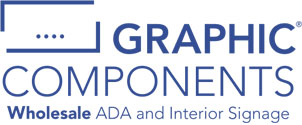Photopolymer ADA Signs Are Better For The Environment

3 HIDDEN ENVIRONMENTAL COSTS OF THERMOFORMING
When putting together a new project, architects and designers place a special focus on the materials they use, gravitating towards materials that both perform as engineered and cause minimal impact to the environment. The problem is the decision on materials, more often than not, does not extend to signage, leaving an area open that can potentially increase the impact on the environment.
Thermoforming, also referred to as compression, is a highly vandal-resistant process within the sign industry. Similar to photopolymer signs, thermoformed signs are produced as a single piece; however, the process of creating them is very different and is seen to be harmful for the environment in several ways.
1. Thermoforming Utilizes Excessive Energy + Resources
Requiring a separate processing machine, a CNC router, special materials, and more, thermoforming is an energy intensive process. The process involves an extremely large amount of heat to form the acrylic signs, power to run the machines, and complete all of the routing. Some companies do not regularly count routing as a cost, but it should be noted that thermoforming consumes a significant amount of routing time that could otherwise be used for other fabricating applications. Combine all of this together and it is easy to see how exhaustive the thermoforming process can be for companies and the environment.
2. Thermoforming Does Not Support Recycling
To begin the thermoforming process, a mirror image of the desired sign must be routed into a mold, which includes letters, pictograms, and braille. This mold is then placed inside of the press with the acrylic that has been trimmed down to the same size as the mold. Special materials are also added to separate the acrylic from the mold. Once the two pieces are separated, the process is complete and you now have your fully acrylic sign, but what do you do with the mold?
“99 times out of 100, you’ll never be able to use [the mold] again. So, you just have to throw it away. The nature of ADA signage is that you make a sign to identify a room by either a unique number or name, so, for example, you really can’t have two Room 101s in the same building,” said Vince Cvijanovic, Co-Owner of Graphic Components. “And, the molds are pionite laminate, making it very difficult to recycle.”
3. Thermoforming Is Vulnerable to Mistakes
The abundance of resources and equipment needed for thermoforming creates many opportunities for the process to go wrong. If there is a mistake on the mold, the whole mold will go to waste and the sign to will have to restart. ADA laws and regulations state that signs that designate permanent rooms and spaces must have a tactile depth of 1/32” minimum. With photopolymer, this requirement is never an issue; however, if there is a routing issue within thermoforming or fluctuation in the amount of pressure and/or heat, the sign may not be deep enough to be ADA compliant—creating more wasted materials, resources and time.
Overall, perceived the low cost of thermoforming comes at a high price for the environment. Between the significant number of resources, the inability to recycle, and the high risk of mistakes, thermoforming has a fairly large carbon footprint compared to photopolymer signage.
Photopolymer ADA signs are the most established type of ADA signs and are among the most vandal resistant. NovAcryl PT series photopolymer is the greenest and most versatile line of signage photopolymers ever introduced. Features include a unique, clear PETG sign base that contains a minimum of 40% post-industrial recycled content which is resilient and shatterproof.
GRAPHIC COMPONENTS IS A

Want to learn more about Photopolymer? CLICK HERE!
CLICK HERE to see more of our processes!
